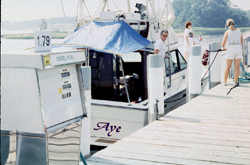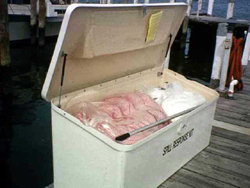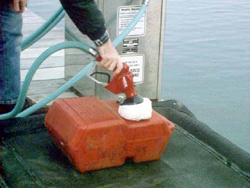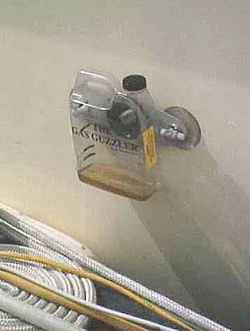New York Sea Grant's
Marina Pollution Prevention Web Site
Section 4: Fueling
- Fuel
Station Operation
Potential Environmental Impacts
Small spills associated with boat fueling can accumulate and become
a much larger problem.  According
to the EPA, complex hydrocarbon compounds in oil and gasoline
are toxic to marine life, upset fish reproduction and interfere
with growth and reproduction of bottom dwelling organisms. Oil
and gas that are ingested by one animal can be passed to the next
animal that eats it. In a marina, petroleum will also deteriorate
the white Styrofoam in floats and docks, and discolor boat hulls,
woodwork and paint. Gasoline spills are also a safety problem
because of the product's flammability. A single pint of petroleum
product released into the water can cover one acre of water surface
area and can seriously damage aquatic habitat.
According
to the EPA, complex hydrocarbon compounds in oil and gasoline
are toxic to marine life, upset fish reproduction and interfere
with growth and reproduction of bottom dwelling organisms. Oil
and gas that are ingested by one animal can be passed to the next
animal that eats it. In a marina, petroleum will also deteriorate
the white Styrofoam in floats and docks, and discolor boat hulls,
woodwork and paint. Gasoline spills are also a safety problem
because of the product's flammability. A single pint of petroleum
product released into the water can cover one acre of water surface
area and can seriously damage aquatic habitat.
Best Management
Practices
To the extent
possible, locate fuel docks in protected areas to reduce potential
for accidents due to passing boat traffic, and design them so
that spill containment equipment can be easily  deployed
to surround a spill and any boats that may be tied to the fuel
dock.
deployed
to surround a spill and any boats that may be tied to the fuel
dock.
Store spill
containment and control materials in a clearly marked and easily
accessible location, attached or adjacent to the fuel dock. A
rule of thumb is that you should have an oil absorbent boom three
times as long as the length of the longest vessel that will be
using the facility. For examples of spill containment product
manufacturers, click
here.
Keep oil absorbent
pads and pillows available at the fuel dock for staff and customers
to mop up drips and small spills.
Carry vent
line whistles, vent cups, oil absorbent fuel collars and other
fuel spill preventative devices in your ships store. For examples
of recreational boat fuel spill prevention devices, click
here.
 Provide
a stable platform for fueling personal watercraft, if your facility
services significant numbers of them.
Provide
a stable platform for fueling personal watercraft, if your facility
services significant numbers of them.
Routinely
inspect and repair fuel transfer equipment, such as hoses and
pipes.
Place plastic
or nonferrous drip trays lined with oil absorbent materials beneath
fuel connections.
Train
fuel dock staff to handle and dispense fuel properly. Many drips
and small spills originate at the fuel dock. Fuel dock staff should
be trained to:
- Fill tanks
slowly and carefully
- Prevent
overfilling of gas tanks by listening to or keeping a hand at
the air vent, if possible; a pronounced flow of air is emitted
when the tank is nearly full
- Remember
that fuel expands in warm weather and to leave at least 5% of
space in a fuel tank to allow for that expansion
- Attach
a container or absorbent pad to the external vent fitting to
collect overflow, as a precautionary measure. Several products
attach to the boat with suction cups

- Keep an
absorbent pad or pillow ready to catch spills, drips, or overflow
- Put a drip
pan under portable fuel tanks. If possible, fill portable fuel
tanks ashore
- Prevent
spills as well as respond to spills
- Give information
and direction to customers. For sample text for a fueling
sign click
here.
Regulatory
Issues
All
marine service stations are subject to the National Fire Protection
Association's (NFPA) Automotive and Marine Service Station Code
(NFPA 30A). (To view a copy of this section of the code on-line
at the NFPA Web site, click
here.) These requirements are adopted locally.
Check with your municipal fire marshal for local requirements,
or contact the State Fire Marshall's Office (In New York call
(518) 474-6746 or e-mail at fire@dos.state.ny.us).
The following requirements are listed in NFPA 30A as pertaining
to marine service stations. (Note: this is not intended to be
a complete list of all requirements):
- Dispensing
nozzles must be of the automatic-closing type without a latch-open
device or holding clip [NFPA 30A, Section 10-4.2].
- All marine
service stations must be attended by an employee responsible
for supervising, observing, and controlling the dispensing of
liquids whenever the station is open for business [NFPA 30A,
Section10-4.7].
- At least
one fire extinguisher with the minimum classification of 40-
B:C must be located within 100 feet of each pump, dispenser,
and pier mounted liquid storage tank [NFPA 30A, Section10-8.1].
- Signs with
the following legends printed in 2-inch (5cm), red block capital
letters on a white background must be posted in the dispensing
area of all marine service stations [NFPA 30A, Section 10-11.8]:
BEFORE
FUELING:
a) Stop all engines and auxiliaries
b) Shut off all electricity, open flames and heat sources
c) Check all bilges for fuel vapors
d) Extinguish all smoking materials
e) Close access fittings and openings that could allow fuel
vapors to enter enclosed spaces of the vessel
DURING
FUELING:
(a) Maintain nozzle contact with fill pipe
(b) Wipe up spills immediately
(c) Avoid overfilling
(d) Fuel filling nozzle must be attended at all times
AFTER
FUELING:
(a) Inspect bilges for leakage and fuel odors
(b) Ventilate until odors are removed
If your facility
stores 10,000 pounds or more of gasoline (about 1626 gallons),
diesel fuel, and/or fuel oil (about 1390 gallons), either above-
or underground for dispensing or for on-site use, you must report
storage of that substance under the Emergency Planning and Community
Right-to-Know Act of 1986 (EPCRA) [40 CFR 355, click
here]. For more information on EPCRA requirements,
click
here.
Any petroleum
product that is discharged to the waters of the state must be
reported to the state (In New York call the NYSDEC Oil Spill Hotline
at (800) 457 7362) For more information on spill response requirements,
click
here.
If any petroleum
product discharged into navigable waters causes a visible sheen,
it may also be necessary to report the discharge to the National
Response Center at (800) 424-8802.
A hazardous
waste determination must be conducted on any materials used to
clean a spill to determine whether or not disposal of the materials
is subject to hazardous waste regulations [40 CFR 262.11, click
here]. For more information on New York hazardous
waste testing requirements, click
here. If they are hazardous, they must be managed
as a hazardous waste. For more information on New York's Hazardous
Waste Regulations and storage requirements, click
here.
If there is
a stormwater discharge from your facility you may have to register
for a General Permit for the Discharge of Storm Water Associated
with Industrial Activity ("Storm Water General Permit").
For more information on storm water permitting in New York,
click
here.

